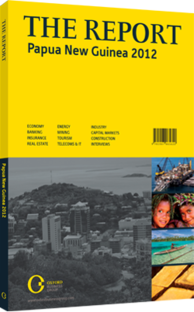Planning for expansion: A new development strategy lays out the central bank’s goals through the end of 2015
In late 2011 the Bank of Papua New Guinea (BPNG), the country’s central bank, launched its 2012-15 Strategic Plan, which will serve as a blueprint for the financial services sector. The plan is made up of a number of major development initiatives, in addition to more general goals and strategic objectives. Broadly, it represents a mandate for BPNG to continue to expand its regulatory capacity in relation to all sector aspects. The plan lays out six key areas of focus for the central bank: monetary policy management; financial market and foreign reserve management; payments system reform management; supervision and development of the financial system; financial inclusion and financial literacy; and upgrading internal capacity.
CONSTANTLY IMPROVING: The 2012-15 plan picks up where BPNG left off after completing a previous fouryear development strategy in 2008. The 2005-08 Strategic Plan, the bank’s first such initiative, outlined several improvements based on the core functions of the bank, including formulating and implementing monetary policy; maintaining price stability; ensuring the steadiness of the financial system; implementing an efficient payments system; and promoting growth. The 2012-15 plan, launched in November 2011, was designed to be flexible and responsive to rapidly changing international and domestic situations. The plan emphasises the need for BPNG to work closely with the Treasury and the Department of Finance to coordinate monetary and fiscal policy, particularly once ExxonMobil’s PNG liquefied natural gas (LNG) project begins producing in 2014. According to the plan, the 2012-15 period will be characterised by rising liquidity levels in the domestic banking system. For the economy at large, this could have a negative impact on aggregate demand, inflation, the kina exchange rate and macroeconomic stability. The plan also takes into account the potential expansion of banking services to rural areas through 2015, primarily as a result of growth in mobile handset-based banking and other new technologies, which will allow financial institutions to reach previously underbanked rural communities. “The advancement of microfinance, internet and mobile banking has now made it easier to provide financial services to those who have never had any form of financial services available to them before,” said Don Pomb Polye, the minister for finance, in a speech delivered during the plan’s launch.
According to strategy documents accompanying the 2012-15 plan, these developments could lead to the consolidation of PNG’s “‘two-speed’ domestic economy, with expanding mineral, transport, manufacturing and construction sectors, and slower-growing agricultural and traditional sectors.”
KEY DEVELOPMENT AREAS: BPNG’s monetary policy strategy through 2015 will be aimed primarily at implementing sound investment and liquidity management plans in preparation for windfall tax and other revenue streams from the PNG LNG project. In particular, the strategy emphasises the importance of ensuring revenues from the project are not deposited in government trust accounts at commercial banks. BPNG has also been working to implement a new kina-denominated automatic transfer system. The new system will facilitate same-day cheque and money transfer clearance; currently it can take a week to clear a cheque.
In terms of supervision of the financial system and upgrading internal capacity under the 2012-15 strategy, the central bank will continue to work to implement best practices, improve regulatory framework and enforcement protocols, and build on existing capacity. Finally, increasing financial inclusion and literacy is a central area of focus. According to the plan, “Many Papuans find themselves on the fringes of the monetary economy with little understanding of, or access to, financial services.” Increasing the proportion of the banked population and enhancing financial literacy is expected to have gains for both this segment and the economy as a whole. It will, according to the plan, “empower them to improve outcomes in savings, investment and sharing of the benefits of economic growth.”
You have reached the limit of premium articles you can view for free.
Choose from the options below to purchase print or digital editions of our Reports. You can also purchase a website subscription giving you unlimited access to all of our Reports online for 12 months.
If you have already purchased this Report or have a website subscription, please login to continue.

